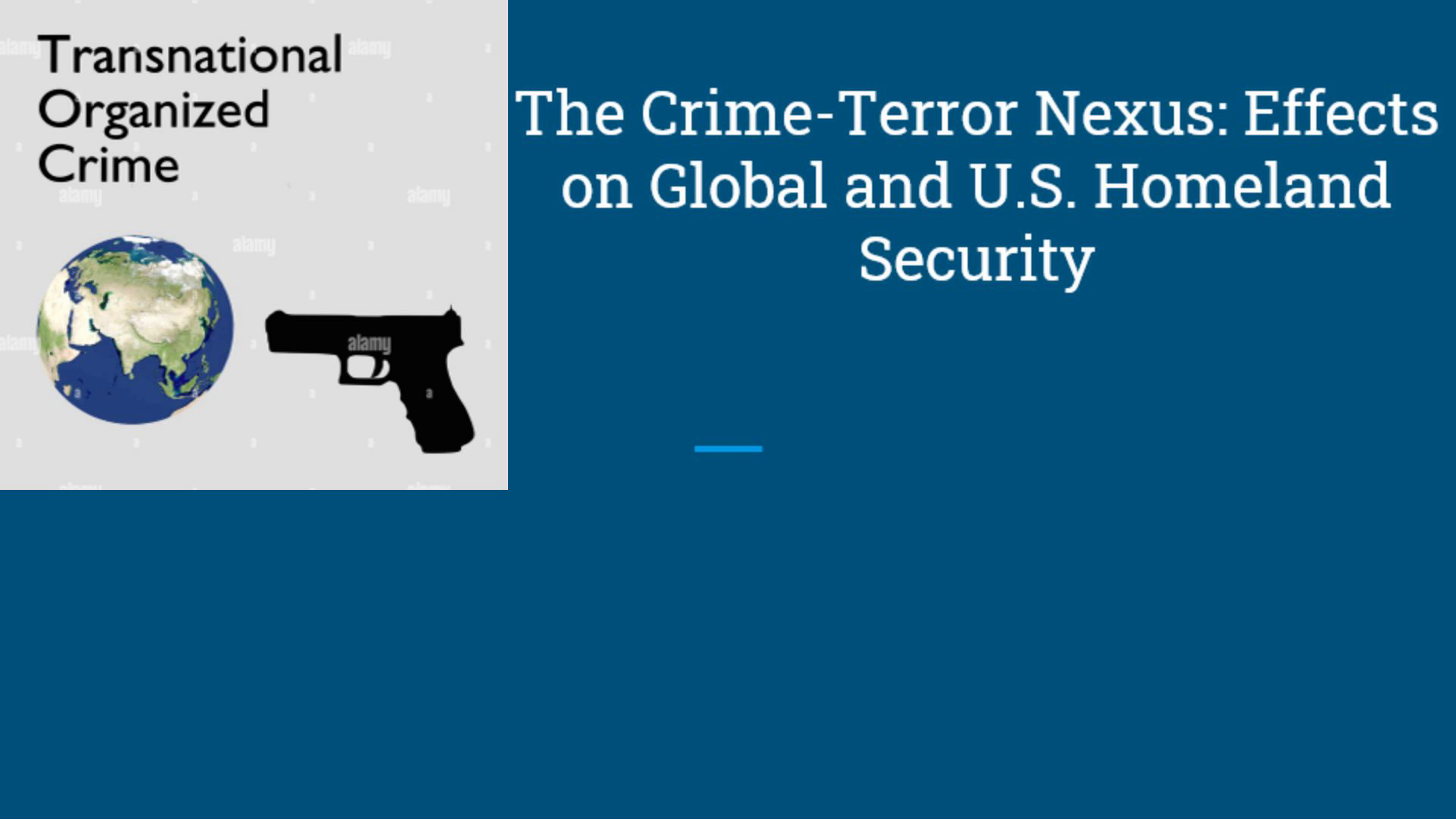
The Crime-Terror Nexus: Effects on Global and U.S. Homeland Security
Scene 1 (0s)
The Crime-Terror Nexus: Effects on Global and U.S. Homeland Security.
Scene 2 (16s)
Transnational Organized Crime: A Global Threat. TOC involves criminal activities across national borders Includes drug/human/arms trafficking, money laundering Exploits global trade, technology, finance systems for illicit activities Undermines economies, corrupts governance, destabilizes societies Employs advanced tech, forms alliances to increase capacity/reach.
Scene 3 (34s)
Terrorism: Ideological Motivations. Driven by political, religious, social ideological motivations Exploits areas with limited governance as bases for attacks Internet facilitates spread of extremist views, recruitment Online platforms used for propaganda, radicalization worldwide Cross-border nature, impacting global peace and security.
Scene 4 (50s)
[image] terrorism. Terrorism: Global Impact. Increased security measures and surveillance to counter terrorism Heightened political tensions, stricter immigration policies Human/economic costs - lives lost, communities displaced, economies disrupted Incites fear, division, xenophobia within societies Undermines global peace efforts, requires international cooperation.
Scene 5 (1m 5s)
The Crime-Terror Nexus. Convergence occurs when TOC and terrorist groups collaborate or adopt each other's methods. Terrorist groups engage in organized crime to fund operations. TOC groups may use terrorist tactics to intimidate, control, influence. Creates complex threat environment. Countermeasures against one can inadvertently empower the other..
Scene 6 (1m 22s)
The Crime-Terror Nexus: Implications for Global Security.
Scene 7 (1m 39s)
The nature of narco-terrorism organized crime. Refers to convergence of drug trafficking and terrorist activities to fund political violence Symbiotic relationship with mutual benefits for traffickers and terrorists Driven by political motivations and economic incentives of lucrative drug trade Poses significant challenges to global security by fueling violence and instability Requires coordinated multi-faceted approach targeting crime-terror nexus.
Scene 8 (1m 58s)
Homeland Security in the United States. Established after 9/11 attacks to protect against terrorist threats Overseen by Department of Homeland Security (DHS) Focuses on preparedness, prevention, response and recovery efforts Coordinates intelligence gathering and information sharing Includes agencies like FEMA, TSA, Secret Service, Coast Guard.
Scene 9 (2m 15s)
[image]. The Challenges the US faces from the TOC-terrorism nexus.
Scene 10 (2m 32s)
[image]. Homeland Security Quadrennial Homeland Security Review (QHSR).
Scene 11 (2m 48s)
Redefining DHS: A New Homeland Security Framework.
Scene 12 (3m 3s)
Strategic Objectives of the Global Initiative Strategy Against TOC.
Scene 13 (3m 17s)
Global Initiative Strategy Against TOC: Cross-Cutting Approaches.
Scene 14 (3m 31s)
[image]. Biblical Analysis. TOC undermines God's vision of peace, justice and human dignity Enables persecution of minorities in volatile regions Threatens national security Comprehensive moral response needed to disrupt these evil networks.
Scene 15 (3m 44s)
References. Albanese, J., & Reichel, P. (Eds.). (2013). Transnational organized crime: an overview from six continents. SAGE Publications, Inc. Alesina, A., Piccolo, S., & Pinotti, P. (2019). Organized crime, violence, and politics. The Review of Economic Studies, 86(2), 457-499. https://doi.org/10.1093/restud/rdy036 Bouchard, M. (2020). Collaboration and boundaries in organized crime: A network perspective. Crime and Justice, 49(1), 425–469. https://doi.org/10.1086/708435 Global Initiative. (2021). The Global Initiative Against Transnational Organized Crimes. https://globalinitiative.net/wp-content/uploads/2021/02/GI-TOC-Strategy-2021-2023.pdf Golubovskii, V., Kostyuk, M., & Kunts, E. (2020). The current state of transnational organized crime. International Journal of Criminology and Sociology, 9, 797-802. http://dx.doi.org/10.6000/1929-4409.2020.09.75 Gunaratna, R. (2018). Global Threat Forecast. Counter Terrorist Trends and Analyses, 10(1), 1–6. http://www.jstor.org/stable/26349852 Howard, A. (2017). Organized crime. (11th Ed). Cengage Learning. McGhee, S. (2022). US Homeland Security. Handbook of Security Science, 63. New International Bible. (2011). The NIV Bible. https://www.thenivbible.com/ (Original work published 1978) Reichel, P., & Albanese, J. (Eds.). (2014). Handbook of transnational crime and justice. Sage Publications. Richelson, J. T. (2018). The U.S. intelligence community. Routledge. Rudman, M., deLeon, R., Martinez, J., Massimino, E., Mathema, S., Mulligan, K., Schmitt, A., & Wolgin, P. E. (2021, June 16). Redefining Homeland Security: A New Framework for DHS To Meet Today's Challenges. Center for American Progress. https://www.americanprogress.org/article/redefining-homeland-security-new-framework-dhs-meet-todays-challenges/ Taylor, R. W., & Swanson, C. R. (2019). Terrorism, intelligence, and homeland security (2nd ed.). Boston: Pearson. Taylor & Swanson (2019) Wheatley, J. (2021). Transnational organized crime: A survey of laws, policies and international conventions 1. Routledge handbook of transnational organized crime, 51–66..